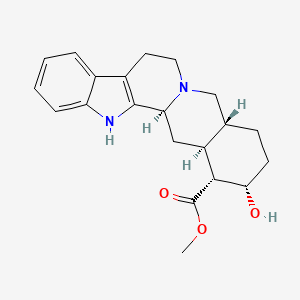D1388 | Yohimbine
G
G04BE04 Yohimbine
[G04BE] Drugs used in erectile dysfunction
[G04B] UROLOGICALS
[G04] UROLOGICALS
[G] Genitourinary system and reproductive hormones
| Toxicity | Dose | Time | Species | Model | Method | Action | Positive criterion | Reference |
|---|---|---|---|---|---|---|---|---|
| OXYGEN CONSUMPTION RATE (OCR) | mouse | neuron | Oxygen consumption rate (OCR) or extracellular acidification rate (ECAR) measurements from permeabilized neurons and isolated brain mitochondria were performed using the XF96 Extracellular Flux analyzer (Seahorse Bioscience). | increase | 269 | |||
| ELONGATION | mouse | neuron | Mitochondrial morphology and neurite area measurements | induce | 269 | |||
| Pictogram | Signal | Statements | Precautionary Statement Codes |
|---|---|---|---|
 |
Danger |
Aggregated GHS information provided by 27 companies from 2 notifications to the ECHA C&L Inventory. Each notification may be associated with multiple companies. H301 (100%): Toxic if swallowed [Danger Acute toxicity, oral] H311 (96.3%): Toxic in contact with skin [Danger Acute toxicity, dermal] H331 (96.3%): Toxic if inhaled [Danger Acute toxicity, inhalation] Information may vary between notifications depending on impurities, additives, and other factors. The percentage value in parenthesis indicates the notified classification ratio from companies that provide hazard codes. Only hazard codes with percentage values above 10% are shown. |
P261, P264, P270, P271, P280, P301+P310, P302+P352, P304+P340, P311, P312, P321, P322, P330, P361, P363, P403+P233, P405, and P501; (The corresponding statement to each P-code can be found at the GHS Classification page.) |
 |
Warning |
Aggregated GHS information provided by 38 companies from 1 notifications to the ECHA C&L Inventory. Each notification may be associated with multiple companies. H315 (100%): Causes skin irritation [Warning Skin corrosion/irritation] H319 (100%): Causes serious eye irritation [Warning Serious eye damage/eye irritation] H335 (100%): May cause respiratory irritation [Warning Specific target organ toxicity, single exposure Respiratory tract irritation] Information may vary between notifications depending on impurities, additives, and other factors. The percentage value in parenthesis indicates the notified classification ratio from companies that provide hazard codes. Only hazard codes with percentage values above 10% are shown. |
P261, P264, P271, P280, P302+P352, P304+P340, P305+P351+P338, P312, P321, P332+P313, P337+P313, P362, P403+P233, P405, and P501; (The corresponding statement to each P-code can be found at the GHS Classification page.) |
| (+)-Yohimbine | (16alpha,17alpha)-17-hydroxyyohimban-16-carboxylic acid methyl ester | (1R,2S,4aR,13bS,14aS)-2-hydroxy-1,2,3,4,4a,5,7,8,13,13b,14,14a-dodecahydro-indolo[2'',3'':3,4]pyrido[1,2-b]isoquinoline-1-carboxylic acid methyl ester hydrochloride |
| 103834-06-6 | 146-48-5 | 17-Hydroxyyohimban-16-carboxylic acid methyl ester |
| 17a-hydroxy-16a-methoxycarbonyl-yohimbane | 17alpha-hydroxyyohimban-16alpha-carboxylic acid methyl ester | 2Y49VWD90Q |
| 37247-87-3 | 4-25-00-01237 (Beilstein Handbook Reference) | 65Y190 |
| AKOS015902024 | APHRODINE | API0006398 |
| Actibine | Amberlite CG-400 | Aphrosol |
| BCBcMAP01_000032 | BDBM50013515 | BDBM50203564 |
| BPBio1_000472 | BRD-K35586044-001-02-6 | BRD-K35586044-003-03-0 |
| BRD-K35586044-003-11-3 | BRN 0097276 | BSPBio_000428 |
| BSPBio_001236 | Benz[g]indolo[2,3-a]quinolizine, yohimban-16-carboxylic acid deriv. | Bio1_000455 |
| Bio1_000944 | Bio1_001433 | Bio2_000458 |
| Bio2_000938 | C09256 | CAS-146-48-5 |
| CCG-205284 | CCRIS 9415 | CHEBI:10093 |
| CHEMBL15245 | CHEMBL537669 | CS-5173 |
| Corynine | D08685 | DB01392 |
| DSSTox_CID_20130 | DSSTox_GSID_40130 | DSSTox_RID_79446 |
| DTXSID9040130 | EINECS 205-672-0 | GS-5751 |
| GTPL102 | HMS1362N17 | HMS1792N17 |
| HMS1990N17 | HMS2089G19 | HMS2234C18 |
| HY-12715 | IDI1_002213 | Johimbin |
| KBio2_000576 | KBio2_003144 | KBio2_005712 |
| KBio3_001031 | KBio3_001032 | KBioGR_000576 |
| KBioSS_000576 | LS-162738 | Lopac0_001210 |
| MCULE-1043513122 | MLS000728591 | MRF-0000020 |
| NCGC00013260-01 | NCGC00025018-05 | NCGC00025018-06 |
| NCGC00025018-07 | NCGC00025018-10 | NCGC00025018-11 |
| NSC19509 | Prestwick0_000584 | Prestwick1_000584 |
| Prestwick2_000584 | Prestwick3_000584 | Q412226 |
| Quebrachin | Quebrachine | SC-25096 |
| SCHEMBL33954 | SDCCGSBI-0051177.P002 | SMP1_000320 |
| SMR000470778 | SPBio_002647 | SR-01000075297 |
| SR-01000075297-5 | Tox21_110019 | Tox21_110019_1 |
| UNII-2Y49VWD90Q | YOHIMBE HYDROCHLORIDE | YOHIMBINE CHLORIDE |
| Yocon | Yohimban-16-.alpha.-carboxylic acid, 17-.alpha.-hydroxy-, methyl ester | Yohimban-16-alpha-carboxylic acid, 17-alpha-hydroxy-, methyl ester |
| Yohimban-16-carboxylic acid, 17-hydroxy-, methyl ester, (16alpha,17alpha)- | Yohimban-16-carboxylic acid, 17-hydroxy-, methyl ester, (16alpha,17alpha)- (9CI) | Yohimban-16alpha-carboxylic acid, 17alpha-hydroxy-, methyl ester (8CI) |
| Yohimbe Extract Yohimbine | Yohimbe bark extract | Yohimbic acid methyl ester |
| Yohimbin | Yohimbine | Yohimbine (DCF) |
| Yohimbol-16alpha-carboxylic acid, methyl ester (6CI) | Yohimex | ZINC3860825 |
| cid_6169 | cid_8969 | methyl (16alpha,17alpha)-17-hydroxyyohimban-16-carboxylate |
| methyl (1S,15R,18S,19R,20S)-18-hydroxy-3,13-diazapentacyclo[11.8.0.0^{2,10}.0^{4,9}.0^{15,20}]henicosa-2(10),4,6,8-tetraene-19-carboxylate | methyl (2S,13bS,14aS,1R,4aR)-2-hydroxy-1,2,3,4,5,8,14,13b,14a,4a-decahydrobenz o[1,2-g]indolo[2,3-a]quinolizinecarboxylate | methyl 17alpha-hydroxyyohimban-16alpha-carboxylate |
| methyl hydroxy[?]carboxylate | trans-Quinolizidine yohimbine | yohimbine;Yohimbine hydrochloride;yohimbine hydrochloride |

